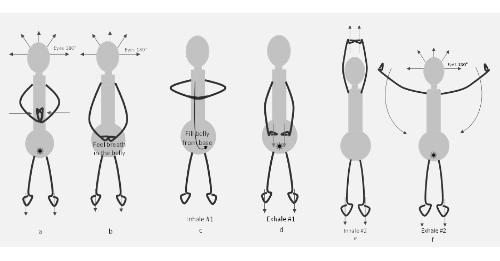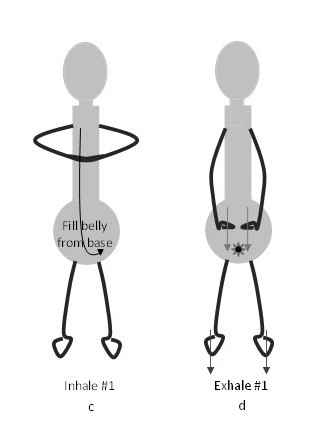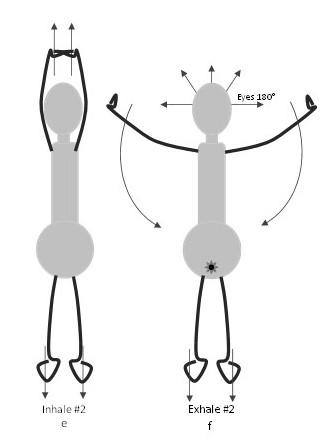Former NASA, Biophysics PhD offers 2-part Mindful Embodied Practice - Your Universal Energy Concentrator

By Ginny Whitelaw, guest contributor
Imagine you’re opening a large, cardboard box. Those of you who remember Wylie Coyote from vintage Road Runner cartoons can see ACME written on the side. This box contains a magnificent contraption: a Universal Energy Concentrator. As advertised, it can turn vision into reality, ideas into actions; YES, it can actually turn energy into things that matter. You can’t wait to try it out, but you can’t figure out how to get it working. You see a few broken parts rolling around in the bottom of the box. It’s out of tune, and it seems to have a mind of its own. Worst of all, it didn’t come with any clear instructions, just a crumpled, coded note that takes you years to decipher, only to reveal a not-very-helpful warning:
DANGER Can cause damage if used improperly. Practice vigorously to use the right way.
WHAT? How do you keep this thing from causing damage? What and how do you practice? How can you use this to materialize your goals and dreams? These are urgent matters for the contraption in question is none other than your own mind-body: the concentration of universal energy into your differentiated self, which can further concentrate or direct energy into the playing field of everyday human affairs.
I’m not speaking metaphorically – OK, the cardboard ACME box was a metaphor – but here’s the truth of your existence: you are part energy and part matter. And life, from birth to death is a flow of energy that keeps materializing. Even matter is a condensed form of energy--something I learned working in a high energy physics lab for 4 years where we studied the energetic conditions that would produce exotic particles. But even non-physicists are familiar with Einstein’s E=mc2, where “c” is the speed of light, roughly 670 million mph that, squared, has 17 zeroes after it. So we can see that even a tiny little mass, “m,” represents a huge amount of “E,” energy. How much energy is concentrated into a massive human body like yours or mine?
But there’s more to it. Matter represents the form of energy that’s relatively stable – slowly changing as compared with, say, the speed of light. We experience these different time tables of change in the solid, liquid, gas, and energetic nature of our own mind-body. For example, our solid bones and muscles change relatively slowly over the timescale of days, weeks, and years. Our emotions, mediated by chemicals flushing through our liquid blood1, endure over the time scale of minutes. Our breath changes direction (in most people) several times a minute. And our energy-induced perceptions and the thoughts they trigger, change on the order of seconds.
These differing time scales of change are part of what makes this mind-body contraption so powerful, as it allows our energetic aspect – mind – to use our relatively solid scaffolding – body – to direct the flow of energy.2 To put it simply: our energy, which interpenetrates with all energy, has legs under it. It has access to hands and feet and can do real work in the world. As Jill Bolte Taylor realized, after suffering a stroke that temporarily wiped out that part of her brain that maintains the illusion of separateness: “We are the power of the universe with manual dexterity.”3
In every moment of our life we’re metabolizing energy and directing its flow.
Even reading these words, you’re directing your brain to take in visual energy and start processing it for meaning. We particularly see this directing of energy in leadership. And by leadership, I don’t mean positional authority, but rather that quality that can arise in any aspect of life or work where we engage whatever’s going on and add our authentic energy to create value, to bring an intent or purpose into the present.4 The entire field of organizational leadership is the play and directing of energy: communication, vision, values, decision making, executive presence, the vibe of a relationship, the quality of meetings, team climate, organizational culture – energy, energy, energy all!
How well we’re able to direct the energy flows in which we play has everything to do with how well we’ve learned to work with our Universal Energy Concentrator. To go back to the metaphor, those parts we see rolling around in the bottom of the box need integrating. The parts that aren’t working need attention. The whole system needs tuning. And the mind of its own that this thing comes with seems concerned only with its own existence. How do we figure out how to use this mind-body system in service of others, in service of the goals and dreams that call us? Once we decipher the clue that it will take vigorous practice, what the heck do we practice?
Powerful as it is, mindfulness that attends to thoughts alone is not enough, for fast-moving thoughts follow the channels set down by the slower-changing body, much as water flowing down a mountain first carves rivulets and then follows them repetitively. Likewise, our mind and life experiences carve the scaffolding of our body, and then the energy of thought, word, and deed follows those pathways, carving them deeper. As neurobiologist, Gerald Edelman, summarized the development of the nervous system, “What fires together, wires together.” Or, as Aristotle observed some years earlier:
“We are what we repeatedly do.”
And we repeatedly do what we are. So if we want to deliver on the promise of our contraption, we need a vigorous discipline that cultivates mind-body-as-one – something that works across energy and matter and all these time scales of change. We need a way to re-direct energy to re-scaffold the body, re-wire how parts work together, re-integrate parts that have been cut off, release the tension that numbs us, re-awaken our senses, and re-align toward the larger purposes that inspire us.
This is the work of mindful embodied practices – practices such as Mindful Leader explored in their recent Embodiment@Work Summit.5 While there are a number of such practices, the examples I can best describe from my own experience come from a deeply physical form of Zen training that has been honing this mind-body system for nearly 40 years. How does it work? While virtually all forms of meditation focus on breath, we regulate breath from the lower abdomen – “hara” in Japanese – sending breath down to build energy and re-integrate every energy center (i.e., the body’s multiple brains in the gut and heart or, from an Eastern view, the chakras6). We slow the breath down to change the vibrational frequency of the body (see Hara Breathing exercise in box). We meditate with all senses fully open, awakening sensitivity to the changing light, the mood of our neighbor, the rhythm of the day. We train with heavy objects and martial movements to re-integrate the energy center of hara in all that we do. We train with sound, using its physical vibration to shake loose tension and bring out our true voice. We train with brush and ink doing large-scale calligraphy to take a snapshot showing how centered is our body, how bright is our energy, and how well are we moving with changing conditions. And through all these disciplines, we increasingly enter the state of Samadhi, where the sense of a separate self drops away. What’s left is all-expansive oneness – and oh yes – the energy of the universe right here, right now, concentrated through these very hands and feet.
I don’t say this is easy. And certainly Zen is not for everyone. But it just may be that pouring yourself into a discipline that integrates mind-body-as-one is right for you. Here you’ve already opened the big cardboard box and pulled out this magnificent contraption. What else is as worthy of your attention as figuring out how to use it?
2-Part Hara Breathing Exercise
This breathing exercise works mind-body-as-one, helping you set your hara, center yourself, and expand your energy at the same time.
a. Set the hara. Stand comfortably, feet shoulder width, knees soft, weight on the balls of your feet. Let your eyes soften to see 180 degrees around you. Press your little fingers together and your big toes into the earth and you should feel an activation at the base of your abdomen that goes away when you quit pressing. Subtly activating this base is called “setting the hara,” and once you get a feel for it, you’ll be able to do it just by the slightest pressure of your toes into the earth. Try this a few times, exhaling down through this center with as little pressure as you can use and still feel the hara set (Figure a).
b. Expand the belly. Now picture your torso in the shape of a thermometer bulb, clear and relaxed on top, with your belly free to expand at the base. Place your hands on your lower abdomen and breathe slowly in and out through your nose, letting tension drop away with every exhale until you can feel your breath move under your hands. (Figure b) Notice if you set the hara on the exhale that the belly does not deflate, i.e., lose its expansion.

c. Inhale #1. Relax on the inhale and let your hands rise to your solar plexus, palms up, allowing the breath to fill the belly from the bottom. Keep your shoulders relaxed. (Figure c).
d. Exhale #1. As you begin your exhale, turn your palms to the ground and gently push them down, setting your hara by directing your breath straight down through the base of the hara, down through the big toes. Let your hara stay expanded. (Figure d)

e. Inhale #2. Relax and release any pressure on the inhale and let your hands rise overhead, extending upward (Figure e).
f. Exhale #2. As you begin your exhale, connect big toes to the earth, setting your hara and let your arms arc slowly back to center, keeping your eyes 180 degrees and seeing both hands in your peripheral vision. Keep an expansive, big feeling throughout the exhale and in the hara (Figure f).
Release and relax on the inhale as your hands rise up and the inhale comes to you (go back to Figure c). Continue alternating the two patterns for at least 3 cycles, making your exhale slower each time.

1. Pert, Candace, Molecules of Emotion (New York: Touchstone, 1997). 2. This is in line with the definition of mind put forth by psychiatrist, Dan Siegel, in the Neurobiology of We (Sounds True, 2014), that is: mind is an embodied, relational process that directs the flow of energy and information. 3. Taylor, Jill Bolte, My Stroke of Insight (New York: Penguin, 2008). This quote comes from a video by the same name. 4.For more on how this directing of energy shows up in leadership, see Whitelaw, Ginny, The Zen Leader (Pompton Plains NJ: Career Press, 2012). 5.Embodiment@Work Summit, April 1-5, 2019. Recorded presentations available online at https://www.mindfulleader.org/page/104390. 6. For more on multiple brains, see Oka, Marvin and Grant Soosalu, m-Braining (Australia: mBIT, 2012). For more on the integration and healing of chakras, see Judith, Anodea, Eastern Body, Western Mind (Berkeley: Celestial Arts, 2004)
Dr. Ginny Whitelaw, author of The Zen Leader, is a Rinzai Zen master in the Chozen-ji line and avid learner in leadership. She is the founder and CEO of the Institute for Zen Leadership, and the President of Focus Leadership, coaching and developing whole leaders for 25 years. Formerly, Deputy Manager for integrating NASA’s Space Station Program, she has a Ph.D. in biophysics, as well as a B.S. in physics, a B.A. in philosophy and a 5th degree black belt in Aikido. To learn more about Ginny, please visit her website. [www.zenleader.global}

0 comments
Leave a comment